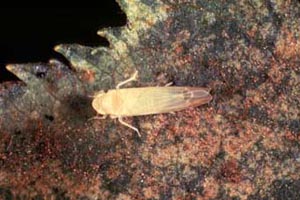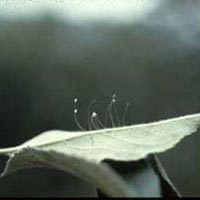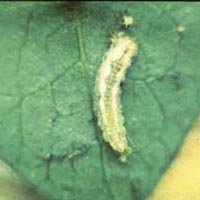|
An Organic IPM Checklist for Vermont
Lorraine P. Berkett1 , M. Elena Garcia2 and Morgan L. Cromwell1
1University of Vermont and 2University of Arkansas
Safety and quality have always been top priorities for Vermont apple growers. IPM is an important component in producing high quality fruit and in reducing pesticide risks in apple production.
We are in the process of examining Organic IPM using organically approved materials, reviewed and approved by the Organic Materials Review Institute (OMRI) and the state's certifying agency. Thresholds used in standard IPM orchards should be viewed as provisionary in organic apple orchards until more experience is gained.
The Organic IPM checklist was developed to serve as a quick reminder of IPM considerations during different times of the year. As such, it does not go into details. It is a "work-in-progress" and will be modified as the authors gain more experience in organic apple production. Details can be found in other publications.
It is the grower's responsibility to ensure that any crop production practice or material used in the orchard is acceptable in their particular state's organic certification program.
Some materials deemed organically acceptable on the National List may not be acceptable in some states. Contact your certifier to know what is acceptable and to ensure compliance with regulations in your state.
December to March
March to Silver Tip Bud Stage
Green Tip through Pink Bud Stages
Bloom
Petal Fall through June
July August September October November
Link to additional IPM Information
December to March
- Evaluate completeness of your IPM records from the previous growing season. In addition to legal requirements, do they reflect scouting information and application of findings in decision-making, do they include tree health information, foliar and/or soil analyses? Does your IPM record-keeping system need improvement?
- Use records to review pest management strategy and results from the previous growing season and make necessary adjustments.
- Read fact sheets, articles and other resources on the biology and life cycles of different orchard pests and beneficial organisms; attend fruit workshops and meetings to obtain updates on thresholds and organic IPM options; get on the mailing and email lists for newsletters and alerts.
- Review materials approved by the Organic Materials Review Institute (OMRI) and accepted by the state's certifying organization for any changes or new organic options.
- Review information on any potential non-target effects of organic options on biological control agents and determine what materials will be effective yet conserve beneficial organisms if intervention is needed.
- Investigate sources of local weather information; determine what equipment will be used to monitor environmental conditions (i.e., rain, temperature, leaf wetness) in the orchard for pest models and for assessing spray conditions.
- Start any major repairs to orchard spray equipment so that it will be ready to calibrate and function properly when the season begins.
- Order IPM monitoring supplies.
- Clean and sharpen pruning tools.
- Prune trees to provide good tree structure but also to open canopy for light and air penetration, which will have both horticultural benefit (i.e., better fruit coloring with more light) and pest management benefits (i.e., make conditions less favorable for disease development; allows better pesticide penetration). Remove cankers, dead or weak wood. Remove mummified fruit.
- While pruning, note any sections of orchard that have high numbers of overwintering European Red Mite eggs.

European Red Mite eggs
- Check for winter damage. Look for peeling or cracked bark.
- Contact beekeeper and write a pollination contract
- Review foliar and soil analysis recommendations. Weak or overly vigorous trees will be more susceptible to certain arthropod pests and/or diseases.
March to Silver Tip Bud Stage
- Conduct final pre-season maintenance check of sprayer(s). Replace worn nozzles, weak hoses, and inaccurate pressure gauges.
- Calibrate sprayers; test spray pattern with water sensitive paper.
- Review tree-row-volume calculations for each orchard block.
- Set up map and record-keeping system for monitoring of orchard blocks
- Check for bud winter damage.
- Remove prunings and brush piles from within and around orchard and burn or chip if possible since they can harbor inoculum for Wood and Fruit Rot diseases and provide habitat for Voles.
- Note Vole activity during snow melt; a lot of activity in the snow could mean high overwintering populations
- As soon as snow cover is gone and the rows are drivable, flail-mow as a sanitation practice for management of Apple Scab (reduces overwintering inoculum).

Flail mowing to reduce Apple Scab overwintering inoculum
- At bud break, begin to calculate and record degree-days for use in predicting Scab ascospore maturity.
- At Silver Tip phenological bud stage, place visual sticky traps for Tarnished Plant Bug and Leafminers in orchard.
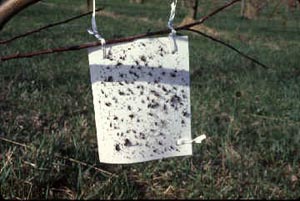 
Tarnished Plant Bug sticky trap (left)
Leafminer sticky trap (right)
- In very young orchards, maintain an 18 inch reduced-weed area next to tree to increase air circulation around tree, to eliminate competition for water and nutrients, and to remove habitat for Voles. An option to maintain a reduced-weed area is bark mulch spread over entire area, but make sure the mulch is pulled away from tree trunks.
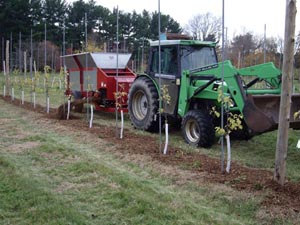
Bark mulch is spread to maintian a reduced-weed area along organic orchard rows
Green Tip through Pink Bud Stages
- Check for bud winter damage.
- Remove solid plastic Vole guards and replace with mesh guards that allow air, light and pesticide penetration. [Impacts Borer management]
- Scout your orchard at least once a week to be aware of what is going on so that if problems are developing, corrective or preventative measures can be taken.
- Monitor weather/environmental conditions for degree-day calculations, disease models, etc., and if intervention is necessary, to determine optimal time to spray to minimize drift.
- At Tight Cluster bud stage and again at the late Pink bud stage, determine the necessity to manage Tarnished Plant Bug and Leafminers.
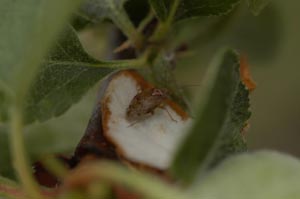

Tarnished Plant Bug adult (left)
Spotted Tentiform Leafminer adult (right)
- Apply oil application(s) for management of European Red Mites and San Jose Scale. [Oil acts to coat and suffocate the overwintering stages.]

European Red Mite eggs
- At early Pink bud stage, place visual traps in the orchard to monitor for European Apple Sawfly. Check at late Pink to see if traps have already reached threshold.

European Apple Sawfly sticky trap
- Manage Apple Scab infections in the primary stage to reduce the need for fungicides during the latter part of the growing season.
- Determine when environmental conditions are favorable for Apple Scab infection periods.
- Begin checking for primary Apple Scab lesions about 9 days after first infection period to determine the effectiveness of your Scab program.

Primary Apple Scab lesions on underside of leaf
Bloom
- Monitor environmental conditions to determine the risk of Fire Blight infection.
- Continue management of Apple Scab.
- Hang Codling Moth pheromone traps in orchard to monitor this insect.

Codling Moth baited pheromone sticky trap
- During late Bloom, begin to inspect fruit on early-blooming cultivars in perimeter rows for fresh Plum Curculio egg-laying scars.
 
Fresh Plum Curculio egg-laying scars with ooze (left)
Crescent-shaped Plum Curculio egg-laying scar (right)
- Bring bees colonies at 10% to 15% bloom
- Monitor pollination conditions.
Petal fall through June
- Scout your orchard at least once a week to be aware of what is going on so that if problems are developing, corrective or preventative measures can be taken.
- If a Fire Blight infection period occurred during Bloom, monitor degree day accumulation and observe blossoms and developing shoots for first signs of blight. The first symptoms of blossom blight is predicted to occur when an additional 103 degree-days have accumulated (base 55F). Depending on how extensive the number of "strikes" are, cut out strikes to reduce inoculum for further disease spread on sunny days when rain is not predicted. Follow recommended procedure for the "ugly stub" method for removing strikes.
 
Fire Blight damage to young fruit (left)
Fire Blight damage to tree (right)
- Check to see if European Apple Sawfly captures have reached threshold levels.
- Inspect fruit for evidence of first signs of Plum Curculio damage; begin to accumulate degree-days for use in model to determine when insect activity is over.
- Examine middle-age fruit cluster leaves to determine if threshold has been reached for European Red Mites.
- Check Codling Moth traps daily and begin to calculate degree-days (base 50F) from first adult catch. An effective time for management of first generation is at 250-360 DD in orchard blocks where the insect is a problem.
- Check for first generation sap-feeding larval mines in leaves to determine if Leafminer threshold has been reached.
- Remove fruit drops, if feasible, to potentially reduce plum curculio populations

Sap-feeding Leafminer larval mines on underside of leaf
- Examine leaves for presence of first generation Leafhopper nymphs and adults to determine if threshold has been reached.
- Assess level of infestation by Aphids and presence of Natural Predators to determine if biological control is likely.
- Hang Apple Maggot Fly traps in orchard during the last week of June to monitor activity and to determine if and when threshold levels are reached.

Apple Maggot Fly sticky red ball trap
- Use the Apple Scab ascospore maturity model to determine the projected end of the primary infection season. As a conservative estimate, the final Scab ascospore release in commercially managed orchards can be assumed to have occurred when 900 DD have accumulated before a daytime rain of at least 0.1 inch and temperatures of at least 50F during the wetting period.
- Before disease management intervals are extended, assess the foliage and fruit for Apple Scab incidence approximately two weeks after the last primary infection period.
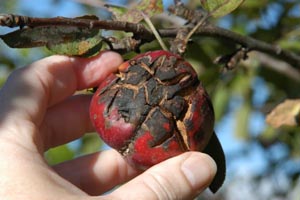 
Scab lesions on fruit (left)
Severe Scab symptoms on leaf ('sheet' scab) (right)
- Keep track of the hours of leaf wetness starting at ten days past Petal Fall in order to determine the period of greater risk of Fly Speck.
- Assess fruit set by monitoring fruitlet growth and weather conditions.
- Mow row middles (if possible, delay mowing until 10-14 days after petal fall).
- Begin organically approved calcium sprays to decrease incidence of Ca deficiencies disorders.
- Monitor soil moisture conditions and irrigate when necessary to avoid dry conditions that can stress trees making them more vulnerable to disease.
July
- Check sprayer calibration and adjust for summer applications.
- In blocks were Codling Moths are a problem, determine if 1260-1460 DD (base 50F) have accumulated from first trap capture in pheromone traps since this is the most effective time for management of second generation.
 
Codling Moth adults on sticky trap (left)
Internal damage caused by Codling Moth larvae (right)
- Check for second generation sap-feeding larval mines in leaves to determine if Leafminer threshold has been reached.
- Examine middle-age terminal leaves to determine if threshold has been reached for European Red Mites.
- Check Apple Maggot Fly traps on a regular basis to determine if threshold has been reached. Clean traps and replace lure every 3-4 weeks.
 
Apple Maggot Fly adult on red sticky trap (left)
Apple Maggot Fly red sticky ball trap (not all insects on trap are Apple Maggot Flies) (right)
- In late July, examine leaves for presence of second generation Leafhopper nymphs and adults to determine if threshold has been reached.
- Continue to keep track of the total number of hours, starting ten days past Petal Fall, that the leaves were wet. Risk of Fly Speck infection increases when 270 hours of leaf wetting have accumulated.
- Begin summer pruning in mid- to late-July to open up the canopy, improving light penetration for better fruit quality, faster drying conditions, and better spray coverage.
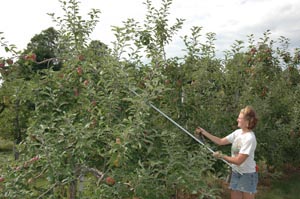
Summer pruning
- Mow grass to discourage Vole populations and to aid in air circulation for disease management.
- Monitor soil moisture conditions and irrigate when necessary.
- Collect leaves for foliar nutrient analysis in late July to early August. Contact your Extension office for specific instructions. Next year’s fertilizer program should be based on the foliar and soil analyses.
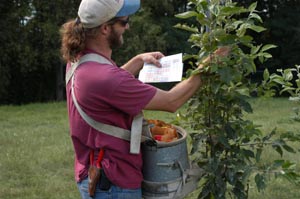
Collecting leaves for foliar nutrient analysis
August
- Continue to examine leaves for presence of second generation Leafhopper nymphs and adults to determine if threshold has been reached.
- Examine middle-age terminal leaves to determine if threshold has been reached for European Red Mites.
- Check Apple Maggot Fly traps on a regular basis to determine if threshold has been reached. Clean traps and replace lure every 3-4 weeks.
- Clean and repair harvesting bags and fruit storage containers.
- Check predicted harvest dates.
- Monitor soil moisture conditions and irrigate when necessary.
- Mow grass to discourage Vole populations and to aid in air circulation for disease management.
September
- Remove or mow fruit drops where feasible as they are a source of food for Voles.
- Note any pest damage during harvest so it can be addressed in IPM planning for the next growing season.
- Mow grass to discourage vole activity.
October
- Check trunks (small diameter trees especially) for signs of Borers.

Roundheaded Borer adult
- After harvest and before leaf fall, estimate the orchard’s level of "Scab risk" by following the sequential sampling procedure.
- Check placement and condition of Vole guards; repair and re-position if necessary.
- Remove or mow fruit drops where feasible as they are a source of food for Voles.
- Mow grass to discourage Vole activity.
- Collect soil for analysis. Contact your Extension office for specific instructions. Next year’s fertilizer program should be based on the foliar and soil analyses.
- Lime soil if recommended by soil analysis.
November
- After leaves have fallen to ground, perform Apple Scab sanitation practices.

Overwintering Scab lesions on fallen leaves
- Paint trunk with organically approved white paint to protect against sudden temperature changes.
- If organically approved Deer repellents will be used, set them before Deer establish a feeding habit. Inspect and make repairs to Deer fence.
- Clean, service and properly store equipment and pesticides.
Photo credits: L.P. Berkett; Integrated Management of Apple Pests in Massachusetts and New England, Coop. Ext. Sys., University of Massachusetts. 1984.; Instructional Media Center, Michigan State University, East Lansing, MI.; W. MacHardy; T.S. Sutton.
Please send comments and suggestions to: lorraine.berkett@uvm.edu
|
























